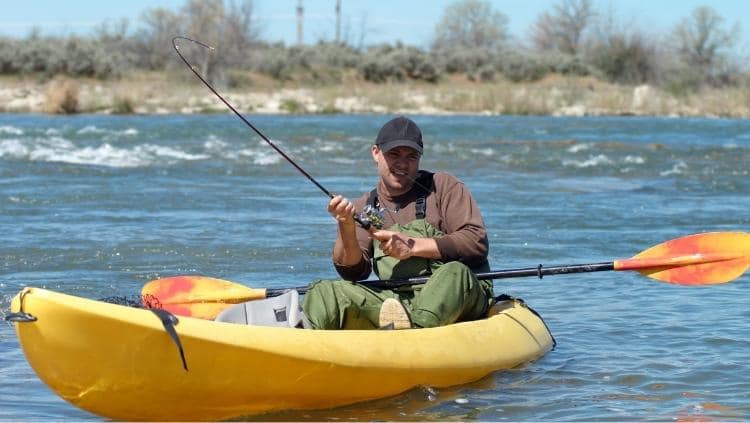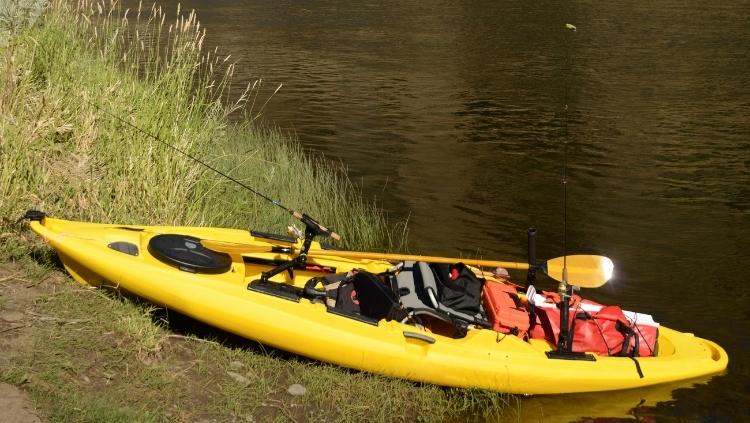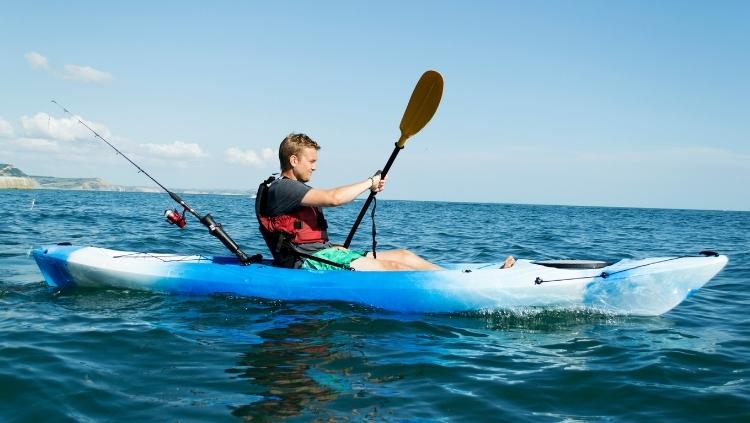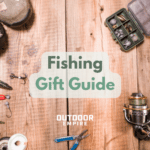Despite the many types of watercrafts available today, the humble kayak has emerged as a favorite fishing platform. They are light, versatile, and relatively cheap.
However, with the proliferation of kayaks on the market, it is essential to know what to look for to differentiate a recreational kayak from a fishing kayak.
There are, in general, four key things that make a kayak a fishing kayak. It should:
- be a sit on top model
- be sufficiently stable
- be equipped to hold multiple rods
- have sufficient storage to hold lots of fishing gear and all the fish you will catch
There are some technical elements that facilitate these features and some other things to consider that we will talk about near the end.
4 Main Features of a Fishing Kayak
When comparing a fishing kayak vs. a regular kayak, there are four main features that, when combined, make the difference.
Sit on Top
Kayaks come in two general form factors. The first, and more traditional type, is the sit-inside kayak. The second is the sit-on-top kayak. Fishing kayaks are sit-on-top style.
On a sit-inside kayak, the top deck of the kayak extends over the front and back of the kayak with only a small hole in the top for the person to slide inside. A spray deck, made of neoprene or nylon, can be used like a gasket to cover the gap between the hole your body, making the inside watertight.
Think of it as wearing the kayak with only your abdomen and upper body sticking out the top. This is good for maneuverability but makes it hard to fish.
The second type of kayak is the sit-on-top. As the name implies, you sit on top of the deck. The high center of gravity makes it a little more top-heavy and tippy. However, the open deck allows freedom of movement and access to the equipment needed for effective and efficient fishing.
Stability
To be a good fishing platform, the kayak needs to be stable. There is nothing worse than to find out that your perfect cast caused you to lose your balance and capsize your craft, scattering your precious and expensive fishing gear across the bottom of the lake or river.
To compensate for being top-heavy, a fishing kayak is wider and shorter than a recreational kayak. This shape sacrifices speed and tracking ability, but it is worth it to keep your gear on the dry side.
Generally, a fishing kayak should be between 30 and 42 inches across at the widest part.
Rod Holders
Probably the biggest difference between a recreational and fishing kayak is the ability to hold fishing rods.
There are two different ways to secure a rod to the kayak, and both need to be present.
First, the kayak should have a way to hold multiple rods secured horizontally against the deck for easy transport and storage when not being used.
The second way of securing a rod to the kayak is in a vertical mount. Multiple vertical mounts can be useful depending on the type of fishing you want to do.
Storage
Fishing can be a gear-intensive sport, and a fishing kayak needs to accommodate all of that gear.
Additional storage can also come in handy if, you know, you actually catch fish and want to keep them for a tasty treat later on.
Storage comes in two types – on top of the deck or below the deck.
On top of the deck, storage can be easily accessed but may get wet throughout the course of a day on the water. Fishing gear can be expensive, so make sure that any deck storage has multiple tie-down points to keep it secured.
The second type of storage is below deck storage. These come in waterproof compartments built into the deck and are accessed through watertight hatches. While convenient for holding gear that needs to stay dry, these compartments are often difficult to access while on the water.
Bonus Features of Premium Fishing Kayaks
Here are some other things to look for, usually found in high-end fishing kayaks. Keep in mind, though, that while these things might come in handy, they are not deal-breakers. Some can even be added on later.
1. A way to secure the paddle to the deck when not in use.
2. Some fishing kayaks come with pedals that manually drive a propeller. This is a handy way to maneuver the kayak while keeping a rod in your hand so you can keep fishing.
3. An anchor can also add convenience, allowing you to stop and fish a honey hole without drifting with the current.
Things to Consider When Shopping for a Fishing Kayak
Cost, weight, portability, and comfort need to be considered when you are looking to buy a fishing kayak.
Budget for Good Quality
Kayaks come in a wide range of prices depending on features and manufacturers.
In my opinion, it is easier and cheaper, in the long run, to pay for quality and what you want upfront.
Buying a cheap imitation fishing kayak might feel like a good idea until it breaks after the first season. And there’s a good chance you’ll find it uncomfortable or lacking the features you want or need. Then, you end up buying a second kayak, the one that you wanted all along.
At least, that’s the argument I use with my wife.
Recommended reading: Best Fishing Kayaks: The Definitive Guide with In-Depth Reviews
Weight Determines Portability
Weight and portability will also be important. A light kayak is crucial if you plan on carrying it ways to the water’s edge or having to portage. Lightweight kayaks will sometimes lack features, but those features will seem extravagant when carrying it any distance.
On the other hand, if you can back the kayak into the lake or river straight from a vehicle, then the weight won’t be as big of a deal.
The tradeoffs are for you to make, but before you put money down, make sure that you can lift the kayak onto your truck or trailer.
No truck or trailer? Best Kayak Roof Racks For Cars Reviewed
Test for All-day Comfort
The kayak should also be comfortable to sit in for long days on the water. This will be different from one person to the next.
The only real way to know if a kayak is comfortable is to try it out. For that reason, it is crucial to try out as many kayaks as you can before putting your hard-earned money on the table.
One way to try out a large assortment of kayaks is to attend an on-water expo and demo. There you can try out different types of boats and talk to experts about the different types of features.
Another way is to borrow your buddies’ boat if he will let you. Or perhaps you can find one to rent for a day first.
Either way, having hands-on experience with as many kayaks as you can before you buy one is the best.
Fishing Kayak FAQs
Can you fish from a non-fishing kayak?
While it’s true that you can fish from anything that floats, having a kayak designed especially for the task can make the experience better. Being more efficient should lead to more fish on the hook.
You can fish from a non-fishing kayak, but you might struggle to stow your gear, secure your rods, and stay upright.
Are fishing kayaks slower?
Fishing kayaks can be slower than other types of kayaks because they have a wider hull, the bottom of which is typically flatter than other kayaks. This favors stability over-speed or agility.
Kayaks built for speed are generally longer with a more narrow, v-shaped hull, making them track straighter and faster.
Is a fishing kayak worth it?
Whether a fishing kayak is worth it to you will depend primarily on how much you expect to use it and whether you need it to be multi-purpose.
For infrequent anglers, a more multi-purpose kayak that works for fishing without the bells and whistles or even an entirely different type of boat might make more sense.
For someone who is going to fish from a kayak more than 5 times per year, you’re most likely to get your money’s worth over the life of the kayak.
Conclusion
Fishing from a boat has been going on for thousands of years. It offers unique advantages not found by our earth-bound fishing brethren.
A fishing kayak allows access to water that you cannot achieve on land. It enables the fisherman to move easily from one area to the next. It’s also quiet, allowing you to sneak up on unsuspecting fish.
Over the last several years, the kayak has emerged as a light, efficient, and effective fishing platform. Choose a kayak with the features you need, and you will be blissfully catching fish for years to come.
Our Must-Read List:







